Nine Questions on Shear Force and Bending Moment
Question.1. Define Beam.
Answer.
A beam is a piece of structure which can take forces or couples acting at right angles to its longitudinal axis. Generally a beam is a horizontal member of moderate size and is made up of one piece.
Question.2. What do u mean by cantilever?
Answer.
A beam having one end fixed and other end free, is known as cantilever beam. Fig. shows a cantilever with end ‘A’ rigidly fixed into its supports, and the other end ‘B’ is free. The length between A and B is known as the length of cantilever.

Fig. Cantilever
Question.3. What is simply supported beam?
Answer.
A beam having both ends freely resting on supports, is called a simply supported beam. The reactions act at the end of effective span of the beam. Fig. 3(a) and Fig. 3(b) show simply supported beams.

(a) (b)
Fig.3
Question.4. Define overhanging beam.
Answer.
A beam for which the supports are not situated at the ends and one or both ends extend over the supports, is called a overhanging beam. Fig. 4(a) and Fig. 4(b) represents the overhanging beam.

(a) (b)
Fig. 4
Question.5. Define continuous beam.
Answer.
Continuous beam : A beam having more than two supports, is called as continuous beam. The supports at the ends are called as the end supports, while all other supports are called intermediate support. It may or may not have overhangs. Fig. 5 shows a continuous beam.

Fig. 5 Continuous Beam
Question.6. What do u mean by U.D.L?
Answer.
A uniformly distributed load implies a constant intensity (W). Its unit is kN/m. Fig. 6 represents a U.D.L between points A and B.

Fig. 6 Uniformly Distributed Load on Simply Supported Beam
Question.7. Define point of contraflexure.
Answer.
The point on the beam where B.M changes sign from positive to negative or vice versa i.e. where the B.M. is zero is known as the point of contraflexure. This is also known as point of inflexion.
Question.8. Define beam. Name its various types. Name types of loading on the beam.
Answer.
A beam is a piece of structure which can take forces or couples acting at right angles to its longitudinal axis. Generally a beam is a horizontal member of moderate size and is made up of one piece.
Types of Beams:
- Cantilever beams
- Simply supported beams
- Overhanging beams
- Propped cantilever beams
- Fixed beams
- Continuous beams.
Types of Loading:
- Concentrated or point load
- Distributed load:
- Uniformly distributed load
- Uniformly varying load
3. Couple
Questin.9. Explain the concept of shear force and bending moment.
Answer.
Shear force at any section of beam is defined as the algebraic sum of all the vertical loads acting on the beam on either side of the section under consideration.
Sign Convention
- Upward loads to the left of section or downward loads to the right of it are considered as positive.

Fig.
- Downward loads to the left of a section or upward loads to the right of it are considered as negative.

Fig.
The bending moment at any section of a beam is defined as the algebraic sum of moments of all the vertical loads (acting either to the left or to the right of the section) about the section.
Sign Convention
- The bending moment producing convexity downwards are known as positive bending moment. The positive B.M. is also known as sagging bending moment. Upward loads on either side of a section produce sagging or positive bending moments as shown in fig.

Fig.
- The bending moments producing convexity upwards are known as negative bending moment. The negative B.M are also known as hogging bending moment. Downward loads on either side of a section produce hogging or negative bending moments as shown in fig.

Fig.
One Response to “Nine Questions on Shear Force and Bending Moment”
tesfaalem
i like your website really,